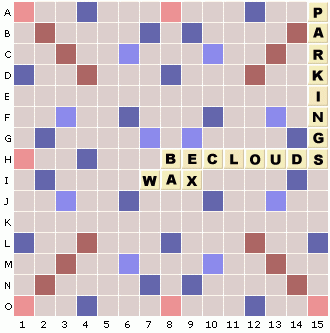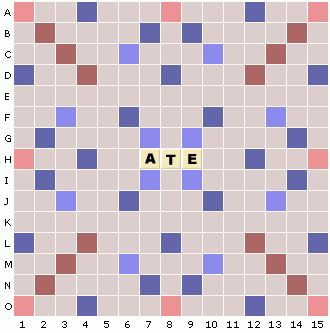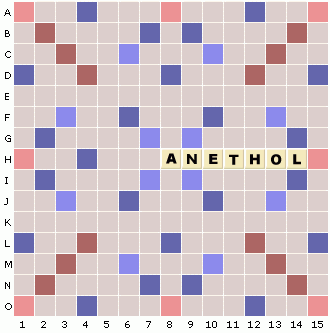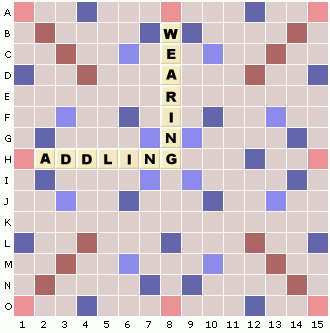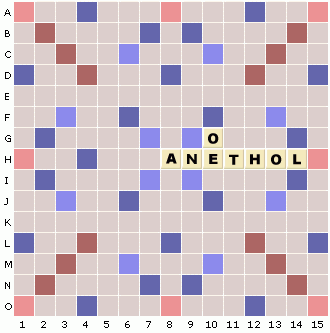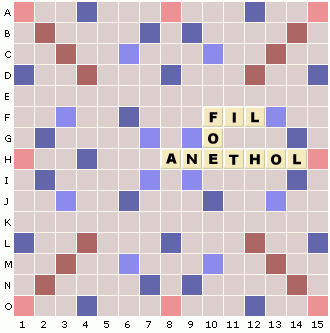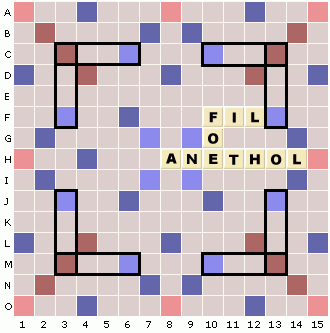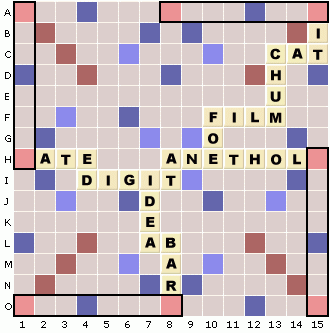|
The Expert's Guide To Scribble |
|
Cooperative? Cooperative means that there is no real winner or loser. Scoring in scribble is simply the total number of points scored by all players during the entire game. Therefore, the main object of the game is to achieve as high a total score as possible. Since this is the "Expert's Guide", we will quickly dipsense with the caveat: "Yes, Scribble can also be played just for fun". :-) This guide will help you to achieve these high scores.
On the main menu is a list of games that are currently running. When someone is playing a game, it will show up as "locked", which means that you can't play until that person is done or until the player's lock times out from inactivity. If you've just played in one of the games, it will be greyed out, since you (or rather, your IP) are not allowed to make two words in a row. Otherwise, you can click on the game number in order to start play. (No matter the status of the game, you can always click on the [see] link to peek at the game without playing.)
When you start a new game, you'll see a board like this:
The object in scribble is to make words on the board using the tiles you have in your possession. To the right of the board, among other things, you will see the tile rack, containing 10 random tiles. As an example:
There are a total of 98 tiles in each game. To become truly proficient at the game, you should memorize the numbers of each tile available during one game. The list is as follows:
Towards the end of any game, there may not be enough tiles left for you to receive 10 on the rack. In that case, there may be as few as one tile.
How To Play Words
To start off, note that you may only make words from left to right or top to bottom. No diagonals or other patterns. As a random example, suppose we wanted to play the word "BED" at F10 (horizontally). First, find the row and column where the word starts. In this case, it begins in row F and column 10. Use the legends at the left and bottom sides of the board to figure this out.
Now, we need to tell it where the word begins. There are three drop-down menus like this under your tile rack:
So simply select the appropriate row, column, and direction ("F",
"10", "across" in this case).
Next, there are two more text boxes under that:
(word) You must of course type the word "bed" (always type the entire
word, not just the tiles you will be placing down) in the word box. If you type something in the chat box, it will be saved with the game so that others can read it. It's nice to make suggestions for future moves, complain about your draw of tiles, or just make friends with the other players. It's not nice to berate other players for making bad words, botching a plan, and such (though they probably would appreciate your suggestions if made nicely)!
Finally, there are three buttons:
Click the first one to submit the word. If you don't like the
letters or just want to try another board instead, click "go back"
(this is superior to pressing "back" in your browser since it
immediately frees up the game for other players). If you think that no more words are possible (for instance, perhaps there is just a single "Q" tile left that won't fit anywhere), then select "no words possible". After a few different people decide that the game can't proceed, it ends and is replaced with a new one. On the beginner boards, it takes approximately 6 consecutive give-ups. On the expert boards, it only takes 2 give-ups. Note that you can't give up on a single game more than once (unless you manage to switch IPs).
Don't worry about submitting words that you aren't sure are legal. The game automatically checks to make sure that your word is valid (it uses the rather extensive Official Scrabble Player's Dictionary version 3, so you might be surprised what's in there!) and you are not penalized for invalid words. Any word that you place down must touch or use existing tiles, except on the very first word (the first word must cross the center square — H8).
How Word Scores are Calculated
Scoring can get somewhat complicated, especially for larger words. Here's what you need to know about scoring — Each tile has a point value. While playing, you can see the point values for the various tiles by clicking on the drop-down box labelled "key", which is repeated here:
Tiles that are harder to use (J, Q, X, Z) are worth more points than easier-to-use (and more common) tiles such as the vowels. These four tiles are referred to as premiums. The "K" is sometimes referred to as a premium tile, as well. I prefer to think of it as a high-scoring non-premium tile, though.
The score of a word is the the sum of the values of the tiles that are in it (this includes tiles already on the board), along with the score of any secondary words that the word might create (for more on secondary words, see below). In addition, you probably noticed that some spaces on the board are colored differently. Those that aren't beige are bonus spaces:
When a tile is placed on a double-letter bonus, for instance, the value of that tile is doubled (This only applies on the turn where that tile is placed down, not in future words that re-use it). Similarly, if any tile in your word lands on a double-word bonus, then the entire value of the word is doubled. (If you can manage to hit two triple-word scores in one play, the word's score is multiplied by nine!)
In addition to all this, there are bonuses for using 7, 8, 9, or all 10 tiles in one play. You'll get an extra 25 points for a 7-letter play, an extra 50 for an 8-letter play, an extra 75 for a 9-letter play, and an extra 100 points if you manage to use your entire rack at once. Making really long words is in your best interest!
For beginners, there is essentially no point to knowing how scores are calculated, since the game calculates them automatically. But for experts, it is helpful to understand in detail how scoring works, to decide, for instance, which of two words would score a higher number of points on a play. To illustrate some examples of how to calculate scores, the following board will serve as a guide:
In this board, we've started the game by playing the word BECLOUD, followed by the word WAX, followed by the word PARKINGS. The first word played, BECLOUD, is worth 51 points. Remember that the B fell on a DWS square, and the O fell on a DLS square. Thus, the point value is calculated thusly: (2 * [BECLOUD]) + 25 (for playing a 7-letter word). This equals (2 * [3 + 1 + 3 + 1 + {2 * 1} + 1 + 2]) + 25, which equals 51 points.
Next, we played the word WAX. Again, remember that the W and X both fell on TLS tiles here. Therefore, this score is calculated like this: [(3 * W) + A + (3 * X)] + [A + B] + [E + (3 * X)]. Note how the secondary words formed (BA and EX) are included in the score. The overall word, therefore scores [(3 * 4) + 1 + (3 * 8)] + [1 + 3] + [1 + (3 * 8)], which equals 66 points.
Finally, we played PARKINGS. Here the P and S fell on TWS squares, and the K fell on a DLS square. The score for this word is as follows: (3 * 3 * [P + A + R + {2 * K} + I + N + G + S]) + (3 * [B + E + C + L + O + U + D + S]) + 50 (for playing an 8-letter word). Plugging in the appropriate tile scores, we get a nice score of 269 points. Pretty good!
Now that you know how to calculate scores manually, let's get to the actual strategies involved in the game...
At The Beginning of a Game
There are two schools of thought on how to start a new game. Before we get to that, though, one thing to not do is to just play a random word through the center of the board. This is how newbies play (no offense), and is not conducive to having a high-scoring game. Since the first word of the game must touch the center square of the board (H8), here are the two ways used by more experienced players to start games:
1. Play a three-letter word, that has the form vowel-consonant-vowel, and start it at square H7. Examples of words that follow this pattern are AGE, OKA, ICE, EVE, or UFO to name a few. The reasons for starting like this will become clear shortly. An example of a board starting like this is as follows:
A related play is to make a three-letter word (with the same vowel-consonant-vowel form) downwards starting at G8. These two plays are essentially identical; neither is "better" than the other.
2. Play a seven-letter word, starting at the center square (H8). The only restriction on the word is that its plural form should also be a word. Thus, for example, DUNGEON would be a good choice, but RELIANT would not be, since RELIANTS is not a word. The word can also be longer than seven letters. The longer, the better, in fact. The key to the first play is that the word must end at H14 (the square immediately to the right of the pink tile at the center-right of the board). Therefore, 8-letter words would start at H7, 9-letter words at H6, and so forth. As before, the reasons for this will become clear shortly. Occasionally, if you're lucky, you might be able to place a word that takes more than just an S. For instance, PERJURE will take a D, R, or S at the end. An example of a board starting like this is as follows:
Related to this play, and equally effective, is the much less frequent "reverse 7-letter start". Instead of playing a word which takes an S at the end, you play one that takes an S at the beginning. As with the normal 7-letter start, sometimes you'll find a word that takes more than just an S at the beginning (i.e., ALLYING takes a D, G, R, S, or T at the beginning!). Two other examples of this sort of start are shown on the following board:
Experts will always start games using the "7-letter" method. Of the current Top 50 games in this site's history, only one was started using the other method, and it was only a fluke of exceptionally good tile order that led to the high score. If you can't start a game this way, the game is generally quit. This process repeats until a 7-letter word (or longer) can be made on the first play.
Set-ups, and More About Colored Squares
As discussed previously, the board contains various colored squares that increase the point value of either one tile or the entire word. These colored squares are key to achieving high-scoring games. More specifically, set-ups of these squares are the key. A set-up is essentially defined as follows: a word that's played immediately adjacent (in any direction) to a colored square. Let's use the board above as an example. Words you play must be connected to tiles already on the board. Therefore, let's say you were to play the word "OE" at G10-down:
The word "OE" can take a D (DOE), F (FOE), H (HOE), J (JOE), R (ROE), T (TOE), V (VOE), or W (WOE). Now, let's say you have a tile rack at this point containing an F tile. The "beginner" way to play would be to simply play the word FOE downwards. This would be worth 10 points — 1 point for the E, 1 point for the O, and 8 points (4 points times 2) for the F. For more information on how scores are calculated, see above.
The expert method is to make a secondary word starting or ending with F (or any other tile that would fit). Let's say you played FIL, across, starting at F10:
In this case, the F is counted twice — once for forming the word FOE, and again for forming the word FIL. Since the F is on a DLS tile, it is scored double-points as well. Therefore, that one F is counted four times! Playing the word FIL would be worth 20 points, quite an improvement over 10 points! I used this particular word as an example to illustrate another set-up — FIL sets up the TLS tile at F13. It could be an E set (FILE), L set (FILL), M set (FILM), O set (FILO), or S set (FILS). Like I said earlier, set-ups can begin or end with the letter in question. So, as an example, you might play the word BERM at C13-down. Without getting into specifics, such a play would be worth 43 points. Compare that with just playing FILM (15 points). Not bad!
Now you hopefully see why a vowel-consonant-vowel 3-letter word isn't a bad way to start a new game. The vowels would have TLS tiles above and below them, and many good set-ups would become possible.
Set-ups II: The 4-Letter DWS/TLS Set
In the previous example, a simple DLS set-up was played, resulting in the F being counted four times. If a similar play was made on a TLS square, the tile in question would be counted six times. Those are the two most basic set-ups to learn. After those, we get to the second-most important set in the game: The 4-letter DWS/TLS set (we'll get to the most important set in the next section). An example of this type of set was shown on the previous board (see above). We had just played the word FIL, setting up a TLS. We could play a two-letter word such as UM, forming the word FILM in the process. This would be worth 25 points. However, it is preferable to play a 4-letter word in this situation, which extends the word to the DWS tile at C13. So let's say we play CHUM instead. In this case, the M would be counted nine times (six times for the basic TLS set, plus an additional three times for the DWS tile). This play would be worth 49 points, again quite an improvement over 25 points. This type of set-up can be made in eight places on the board, in the following positions:
Set-ups III: The 8-Letter TWS/TWS Set
The most important sets in the game are, by far, the sets utilizing two TWS (pink) tiles, with a DLS tile in between them. In any game, such a set is possible only four times. To achieve a high score, all 4 of these sets must be employed. In some cases, as in our board above, this type of set-up will only take an S. Assuming the outer edge of the board is empty, you could play a word beginning with S (starting at H15-down) or ending with S (starting at A15-down). Let's say we played a few more words on our board above. The following board then shows four example sets for these words and where you should place the "big words":
For these set-ups, it is always advantageous to play a set-up that will take an S. This is because 8-letter plurals are more common than 8-letter words without an S. That being said, you will note in our example that with the exception of the ANETHOL set-up, all the sets will take other tiles in addition to the S. Why are these four plays the most important ones in the game? It's because they will score the majority of your points. In an average expert game played well, these four plays will score approximately 70% of the total score! You'll also note that these plays must be, at a minimum, 8-letter words. Again, the bigger, the better. But they have to be at least 8 letters. Why? Because an 8-letter word (or longer) will cross two TWS tiles, thus multiplying the overall point value of the word played by nine, in addition to multiplying the secondary word formed (ANETHOLS, for instance) by three. The lowest possible score you will earn with one of these plays is approximately 140 points! The highest score you can earn is almost 500 points! Not bad for a single play. It goes without saying that you must play all four of these words to have a shot at a really good game.
As an aside, this type of set-up is frequently referred to as a "trip set-up", and the actual 8-letter words is generally called a "trip". This is short for triple-triple. Make sure to use the proper terminology! :-)
The All-Important DLS Squares
You'll note that in each of the above trips, the word played will pass over a DLS square as well. Obviously, in an expert game, there are a total of 4 such DLS squares. These 4 unassuming squares are easily the most important in the game, with regards to getting exceptional scores. The reason? The four tiles played on these four squares will each be counted an incredible eighteen times (triple-word times triple-word times double-letter = 18). Therefore, it is hugely advantageous to try to find words where a high-value tile will fall on these squares. For instance, in the example board above, if we played the word PAROQUET at A8-across, the Q (normally worth 10 points) would fall on the DLS. Since it would be counted 18 times, this one tile alone would contribute a whopping 180 points to the total score! The four highest possible DLS tiles would be the J, Q, X, and Z. Such a game with all four premiums on the DLS has never been played. The closest anyone has come to that lofty scenario were the tiles K, Q, X, and Z. Not surprisingly, that game (1796 points) is currently the highest-scoring game in the history of this site.
I have made a large list, in Excel format, of every valid 8, 9, and 10-letter word in the game that has a premium on the DLS. I don't just give it out to anyone who asks for it, though — I only offer it to players that have established themselves as "experts" and clearly know what they're doing. Let's say this involves regularly participating in games over 1200 points or so. Think of it as a reward for learning how to play well. :-)
On a somewhat humorous side note, you'll note that when some people make a "trip", they will say what tile fell on the DLS (i.e., "C on the DLS"). I started this practice in early 2000, initially only when a premium tile fell on the DLS. Eventually, the experts started saying it for any tile. What's the point, you ask? There is none — it's just a tradition for expert players. If you play such a "trip", feel free to proclaim the DLS tile as well. It identifies you as a proficient player "in-the-know". :-)
Written by Mike (IP - ny325.east.verizon.net), with help from Tom 7.
|

